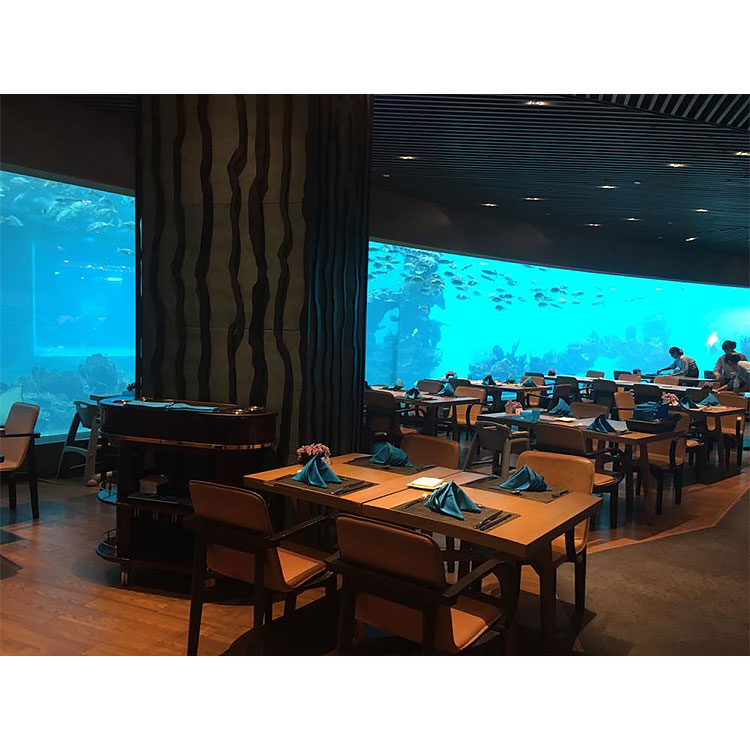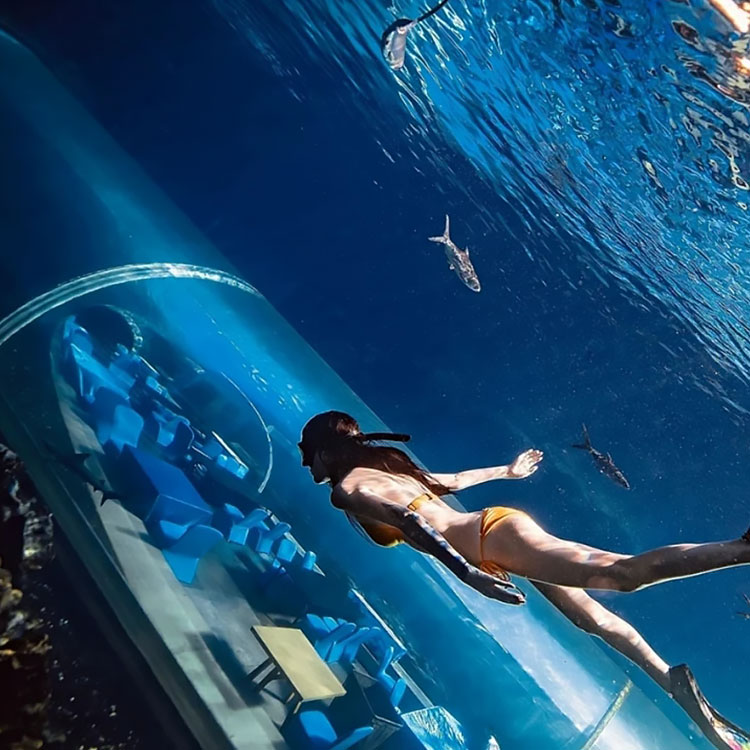Lisbon oceanarium
Lisbon oceanarium is a famous aquarium. Leyu Acrylic Aquarium Factory is specialized in building oceanarium.
Let's explore the ocean world oceanarium, let's go and see the famous Lisbon oceanarium.
The Lisbon Oceanarium, known as Oceanário de Lisboa in Portuguese, is a prominent public aquarium situated in Lisbon, Portugal. It is widely regarded as one of the largest and most impressive oceanariums in Europe, attracting numerous tourists and serving as an important educational center.

Key features of the Lisbon Oceanarium include:
Central Tank:
The oceanarium's main highlight is its colossal central tank, which holds approximately 5 million liters of saltwater. This tank is skillfully designed to simulate the conditions of the open ocean, housing a diverse array of marine life, including sharks, rays, and various species of fish.
Ecosystem Diversity:
The central tank is divided into four distinct ecosystems, representing the Atlantic, Pacific, Indian, and Antarctic oceans. Each ecosystem showcases the specific flora and fauna native to those regions.
Underwater Tunnel:
Visitors have the opportunity to walk through a transparent tunnel that runs right through the central tank. This offers a unique and immersive perspective of marine life swimming all around them.
Themed Exhibits:
In addition to the central tank, the Lisbon Oceanarium boasts several smaller exhibits that feature different marine habitats, such as coastal zones and vibrant coral reefs.
Biodiversity Conservation:
The Oceanarium is deeply committed to promoting awareness and conservation of marine biodiversity. It plays a crucial role in educating the public about the significance of safeguarding our oceans and marine life.
The Lisbon Oceanarium is a must-visit destination for anyone interested in marine ecosystems, offering an extraordinary and enlightening experience for visitors of all ages.

What is the Oceanarium restaurant?
Leyu acrylic aquarium factory specializes in the construction of Oceanarium restaurant.
An oceanarium restaurant typically offers a unique and immersive atmosphere where diners can enjoy their meals surrounded by underwater views or large aquariums filled with marine life. These restaurants often aim to provide a captivating and enjoyable dining experience, especially for families and those interested in marine life.
In an oceanarium restaurant, you might find features like:
Underwater Views:
Some restaurants have walls or large windows that showcase underwater scenes, allowing diners to observe fish, sharks, or other aquatic creatures as they eat.
Aquariums:
The restaurant may have large aquariums built into the decor, containing various marine species, adding to the ambiance and entertainment for guests.
Themed Decor: Ocean-themed decorations, such as nautical elements, seashells, and maritime motifs, create a maritime atmosphere that complements the dining experience.
Seafood Specialties:
Many oceanarium restaurants may emphasize seafood on their menu to align with the marine theme.

What is the ocean world oceanarium?
Ocean World Oceanarium, also known as Ocean World, is an entertainment and educational complex that typically features a large aquarium or oceanarium. It is a popular tourist attraction that showcases a diverse range of marine life, allowing visitors to get up close and personal with various aquatic creatures.
Ocean World Oceanariums usually offer a combination of exhibits, live animal shows, interactive programs, and educational presentations to engage and entertain visitors while promoting awareness about marine conservation and the importance of protecting marine ecosystems.
Key features and attractions you can find in an Ocean World Oceanarium may include:
Large Aquariums:
These facilities house massive tanks filled with seawater, providing a naturalistic environment for marine animals like fish, sharks, rays, and other sea creatures. Visitors can walk through underwater tunnels or viewing areas to observe marine life swimming around them.
Dolphin and Sea Lion Shows:
Ocean World often hosts entertaining and educational shows featuring trained dolphins and sea lions, demonstrating their natural behaviors and intelligence.
Touch Pools:
Some Oceanariums have interactive touch pools where visitors can gently touch and learn about marine invertebrates like starfish, sea cucumbers, and small rays.

How to get rid of algae in fish tank?
To get rid of algae in a fish tank, you can follow these steps:
Reduce Light Exposure:
Algae thrive on light, so reduce the amount of time your aquarium light is on each day. Aim for around 8-10 hours of light, and avoid placing the tank in direct sunlight.
Clean the Tank Regularly:
Perform regular water changes (about 10-25% of the tank's water) every 1-2 weeks to remove excess nutrients that can contribute to algae growth. Use a gravel vacuum during water changes to remove debris from the substrate.
Scrub Decorations:
Algae can cling to aquarium decorations, so use an algae scrubber or brush to clean them regularly during water changes.
Avoid Overfeeding:
Overfeeding leads to excess nutrients in the water, which can fuel algae growth. Feed your fish only the amount they can consume in a few minutes, and remove any uneaten food promptly.
Introduce Algae Eaters:
Certain fish species, like Otocinclus catfish, Siamese algae eaters, or some snail species, can help control algae by eating it. Research and choose species that are compatible with your existing fish.
Live Plants:
Adding live aquatic plants to your tank can compete with algae for nutrients and help keep the algae growth in check.
Use Algaecides with Caution:
While some algaecides can help eliminate algae, they can also harm fish, plants, and beneficial bacteria in the tank. If you consider using one, carefully follow the instructions and use them as a last resort.
Maintain Filter and Equipment:
Regularly clean and maintain your aquarium filter and other equipment to ensure they are working efficiently. A well-functioning filter can help remove excess nutrients that algae feed on.
UV Sterilizer:
Consider using a UV sterilizer, which can help control algae by killing free-floating algae cells as the water passes through it.
Remember that completely eliminating algae is not always possible or necessary. Some amount of algae growth can be natural and even beneficial for the ecosystem in the tank. The goal is to keep algae at a manageable level so it doesn't negatively impact the health of your fish and plants.

English
العربية
Русский
Español
Português
Français
Deutsch
italiano
한국어
Nederlands
Tiếng Việt
ไทย
Polski
Türkçe
አማርኛ
ភាសាខ្មែរ
Bahasa Melayu
தமிழ்
Filipino
Bahasa Indonesia
magyar
Română
Čeština
Српски
हिन्दी
فارسی
Kiswahili
Slovenčina
Slovenščina
Norsk
Svenska
Ελληνικά
Suomi
עברית
Dansk
Shqip
বাংলা
Hrvatski
Afrikaans
Māori
සිංහල
Беларуская мова
Bosanski
ދިވެހި
Esperanto
guarani
Hausa
ʻŌlelo Hawaiʻi
Kurdî
Lietuvių
Македонски
ਪੰਜਾਬੀ
Runasimi
Türkmençe
isiZulu


 +86-13584439533
+86-13584439533 






























